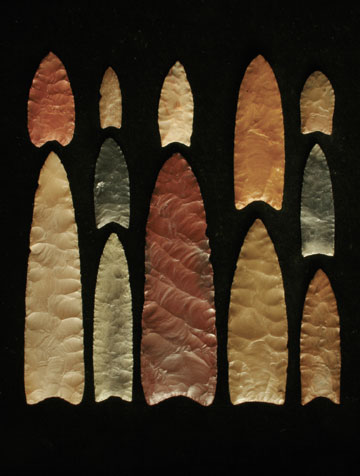 By LEE BOWMAN Scripps Howard News Service February 23, 2007
Perhaps more surprising, though, is that the distinctive stone spear points chipped out by what's come to be known as the Clovis culture became the rage across much of two continents in as little as 200 years.
Clovis points were among the most efficient big-game killers of the Stone Age. Fluted at the bottom so they would break off a spear shaft and remain embedded in prey, they allowed the multiple hits needed to bring down a mammoth or the other large animals that roamed the landscape at the end of the last ice age. Since the signature spearhead was found in Clovis, N.M., in 1933, tens of thousands of the weapons have been discovered in all 48 contiguous states, as well as across Central America. But only a handful of those sites have been reliably dated using the radioactive decay of carbon from plant and animal remains found with the points, and many of those were done decades ago. A team led by Michael Waters, director of the Center for the Study of the First Americans at Texas A&M University, and Thomas Stafford, of Stafford Research Laboratories in Lafayette, Colo., sought to recalibrate the timing of the Clovis culture using modern radiocarbon dating. Their report was published Friday in the journal Science. "It was always argued that Clovis represented the first people who came to the Americas," Waters said. "The new dating that we did indicates that the Clovis Complex ranges from 11,050 to 10,900 radiocarbon years before the present " or about 13,300 to 12,800 calendar years ago. Having a more solid timeline for Clovis is important, because in the past few decades archaeologists have turned up evidence that humans were here as early as 18,000 to 20,000 years ago at sites as far-flung as Virginia, Washington state and Chile. There are debates about the dating of those sites, too. "Slowly but surely, archaeologists have been questioning whether Clovis represents the earliest people to enter the Americas." Using new techniques, Waters and Stafford came up with new dates for a half-dozen Clovis sites. All showed that the spearheads were produced during the more recent time frame and no more than about 400 years. "I think people are going to be surprised by the dates," Waters said. The classic First Americans saga held that people wandered over an ice age land bridge from Siberia into Alaska and through a break in the glaciers covering most of North America into the Great Plains 13,000 years ago, with their descendants spreading out to populate the entire hemisphere in a few thousand years. The Clovis points have been central to the argument that the original immigrants came in one or maybe a few closely spaced waves. They also have been central to scientific arguments about whether the first Americans hunted and ate to extinction most of the big game they encountered - alternate theories also blame new diseases the people carried, or changing climate. Waters and Stafford add support to a growing view that the Clovis points were a great innovation that was copied by everyone who saw them, rather than imported. "These tight dates, if they hold up, may help us resolve that long-standing debate," David Meltzer, a Paleo-Indian specialist at Southern Methodist University, told Science.
On the Net:
Scripps Howard News Service, http://www.scrippsnews.com Publish A Letter on SitNews Read Letters/Opinions
|
||
